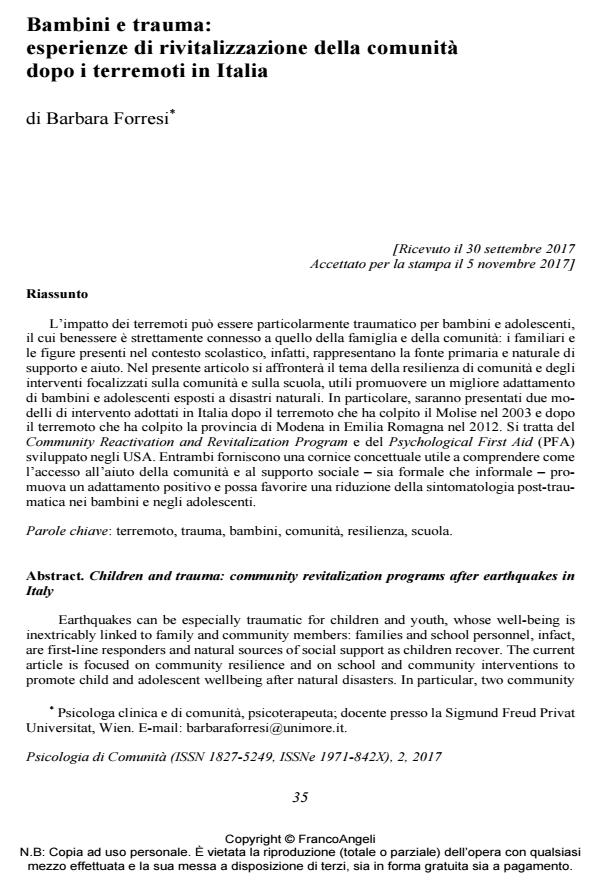Children and trauma: community revitalization programs after earthquakes in Italy
Journal title PSICOLOGIA DI COMUNITA’
Author/s Barbara Forresi
Publishing Year 2017 Issue 2017/2
Language Italian Pages 9 P. 35-43 File size 165 KB
DOI 10.3280/PSC2017-002004
DOI is like a bar code for intellectual property: to have more infomation
click here
Below, you can see the article first page
If you want to buy this article in PDF format, you can do it, following the instructions to buy download credits

FrancoAngeli is member of Publishers International Linking Association, Inc (PILA), a not-for-profit association which run the CrossRef service enabling links to and from online scholarly content.
Earthquakes can be especially traumatic for children and youth, whose well-being is inextricably linked to family and community members: families and school personnel, infact, are first-line responders and natural sources of social support as children recover. The current article is focused on community resilience and on school and community interventions to promote child and adolescent wellbeing after natural disasters. In particular, two community intervention models will be presented, applied after the earthquakes that hit the Molise Region in 2003 and the Emilia Romagna Region in 2012: the Israeli model of the Community Reactivation and Revitalization Program and the Psychological First Aid (PFA), an evidence informed intervention developed in USA. They provide a useful framework for understanding how access to community and social support, both as formal and informal, promotes positive adaptation or reduced post-traumatic symptoms among children and adolescents.
Keywords: Earthquakes, trauma, children, community, resilience, school.
- Brymer M., Layne C., Jacobs A., Pynoos R., Ruzek J., Steinberg A. et al. (2006). Psychological First Aid Field Operations Guide (2nd Edition). Los Angeles, CA: National Child Traumatic Stress Network and National Center for PTSD (trad. it. Caffo E., Forresi B., Scrimin S., a cura di, Primo Soccorso Psicologico. Guida all’operatività sul campo. Milano: Guerini, 2010).
- Buchele B. (2012). The AGPA Institute as a boost to therapist resilience in a post-9/11 world. International Journal of Group Psychotherapy, 62: 615-624.
- Caffo E., Forresi B., Strik-Lievers L. (2005). Impact, psychological sequel and management of trauma affecting children and adolescents. Current Opinion in Psychiatry, 18: 422-8.
- Caffo E., Forresi B., Belaise C., Nicolais G., Laor N., Wolmer L., Remschmidt H., (2004). Innovative intervention in the community. In Remschmidt H., Belfer M., Goodyer J., editors, Facilitating Pathways. Care treatment and prevention in child and adolescent mental health. Berlin: Sprinter, cap. 14: pp. 187-196.
- Forresi B. (2003). Aspetti clinici connessi all’emergenza. In Caffo E., a cura di, Emergenza nell’infanzia e nell’adolescenza. Interventi psicoterapeutici e di comunità. Milano: McGraw-Hill, cap. 3: pp. 45-88.
- Forresi B. (2007). Evidence based intervention and challenges of trauma research with children. The school intervention program after the 2002 earthquake in Molise, paper non pubblicato, presentato al XIII International Congress of the European Society for Child and Adolescent Psychiatry (ESCAP). Firenze, 25-29 Agosto, https://www.youtube.com/watch?v=tL5kVwlvGtM.
- Forresi B., Lopez G., Nicolais G.P., Rossi M. (2003). Un modello di intervento in situazioni di disastro di massa: il Class Reactivation Program. In Eurispes, Telefono Azzurro, IV Rapporto Nazionale sulla condizione dell’infanzia e dell’adolescenza. Roma: Eurispes, cap. 5: pp. 593-622.
- Laor N., Wolmer L., Kora M., Yucel D., Spirman S., Yazgan Y. (2002). Post-traumatic, dissociative and grief symptoms in Turkish children exposed to the 1999 earthquakes. The Journal of Nervous and Mental Disease, 190: 824-832.
- Laor N., Wolmer L., Levi S. (2004). Relief programs in communities affected by disaster: Theory, implementation principles and a case study. In Caffo E., a cura di, Emergenza nell’infanzia e nell’adolescenza ‒ Interventi psicoterapeutici e di comunità, Milano: McGraw-Hill, cap. 7: 201-215.
- Laor N., Wolmer L., Spirman S., Hamiel D., Wiener Z. (2013). Child-Oriented Perspective on Community Resilience. In: Pat-Horenczyk R., Brom D., Vogel J., Chemtob C.M., editors, Helping children cope with trauma: Individual, family and community perspectives. London: Routledge, cap. 10: 165-179.
- Mayes L.C., Cohen D.J. (1990). Preschool Children’s Assessment of Stress Scale. New Haven, CT: Yale Child Study Center.
- Phillips S. (2009). The synergy of group and individual treatment modalities in the aftermath of disaster and unfolding trauma. International Journal of Group Psychotherapy, 59: 85-104.
- Pynoos R., Frederick C., Nader K. (1987). Life threat and post-traumatic stress in school-age children. Archives of General Psychiatry, 44: 1057-1063.
- Righi E., Forresi B., Aggazzotti G., Caffo E. (2016). Il Terremoto dell’Emilia Ro-magna del 2012: Prevalenza e Persistenza del Disturbo Post-Traumatico Da Stress nei bambini e negli adolescenti. In: Giovannini D., Vezzali L., a cura di Unimore e il terremoto del 2012 in Emilia-Romagna. Interventi e ricerche per fronteggiare l’emergenza e sostenere la ripresa. Carpi: APM Edizioni.
- Rodriguez J.J., Kohn R. (2008). Use of mental health services among disaster survivors. Current Opinion in Psychiatry, 21: 370-378.
- Watson P.J., Brymer M., Bonanno G. (2011). Post-Disaster Psychological Intervention Since 9/11. American Psychologist Special Issue: The 10th Anniver-sary of the September 11, 2001 Terrorist Attacks. American Psychologist, 66: 482-94.
- Wolmer L., Laor N., Yazgan Y. (2003). School reactivation programs after disaster: Could teachers serve as clinical mediators? Child and Adolescent Psychiatric Clinics of North America, 12: 363-381. DOI: 10.1016/S1056-4993(02)00104-9
- Wolmer L., Laor N., Dedeoglu D., Siev J., Yazgan Y. (2005). Teacher-mediated intervention after disaster: A controlled three-year follow-up of children’s functioning. Journal of Child Psychology and Psychiatry, 11: 1161-1168.
- U.S. Department of Homeland Security (2008). National Response Framework. Retrieved October 2008, from www.fema.gov/emergency/nrf/.
Barbara Forresi, Bambini e trauma: esperienze di rivitalizzazione della comunità dopo i terremoti in Italia in "PSICOLOGIA DI COMUNITA’" 2/2017, pp 35-43, DOI: 10.3280/PSC2017-002004